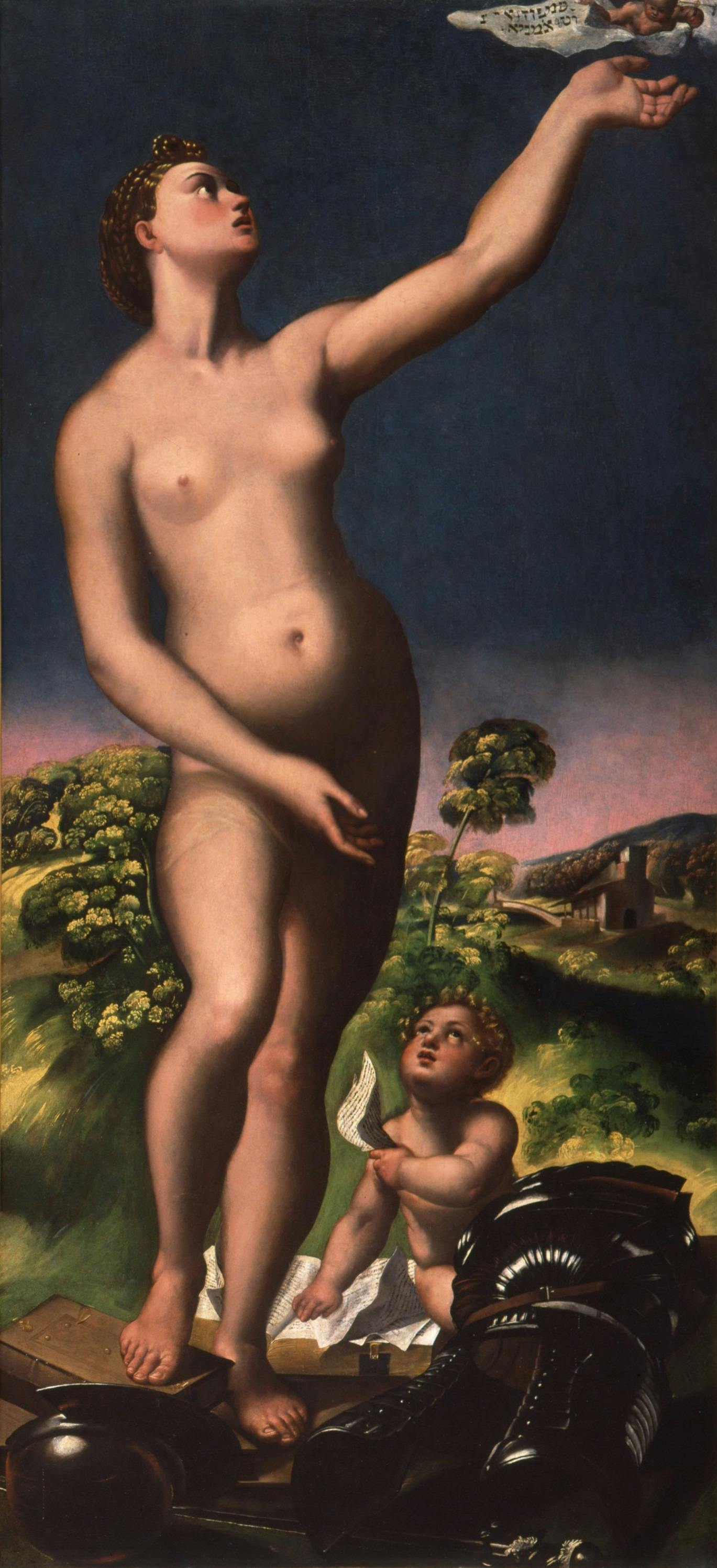Allegory (woman with putto)
Emilian artist (so-called ‘Friulian friend of Dosso’) active in Ferrara, Emilia (between 1510 and around 1540)
Against the backdrop of a fantasy landscape, illuminated by the light of the sunset, stands out a voluptuous, unclothed young woman, while a putto seated on a book is intent on handing her torn pages. Another volume, closed, lies under the woman's foot.
If the right arm is reaching out towards the child, her gaze and left arm are extended towards a tiny angel peeping out of the enamelled blue sky. The latter, while holding a thin cross, hands her a scroll on which was deciphered, in Hebrew characters, the Latin motto Tempus elevat omnia ('time consumes everything'): a reference to the vanity of earthly things that often accompanies the allegory of Truth, which was traditionally represented as a nude female figure. The magnificent armour haphazardly strewn at the feet of the young woman, as well as the pages torn by the putto, are an allusion to time that consumes and condemns to oblivion all worldly glory and wealth. Truth, by abandoning the ephemeral vainglory, rises to the dimension of sacred and biblical wisdom, thanks to the direct contact with the angel.
The solid volumes of the helmet and armour are reminiscent of the portraits 'in arms' by Dosso Dossi, by which the artist was almost certainly inspired. The details of the buckle and the light brush strokes that bring out the metallic reflections can be compared to those of the Portrait of a Warrior in the Uffizi and of the Portrait of Hercules I in the Galleria Estense in Modena.
The reference to Judaic culture has led to the assumption that the work was commissioned from Ferrara, a city with strong relations with the Jewish community that received special privileges by the Este court. The bright greens and the atmospheric contrast of pinkish tones that characterize the view, as well as the solitary tree delineating the perspective planes of the representation, are typical of the pictorial language of Dosso's circle. Precisely because of the morphology of the landscape, the Allegory was included by Mina Gregori among the group of paintings attributed to an anonymous author, who was conventionally named the 'Friulian Friend of Dosso' by Roberto Longhi.
However, the work remains enigmatic, so much so that it was recently compared to a slightly later portrait from the Tyumen Museum in Russia. Nevertheless, the presence of too many differences in style and periodization would not suggest a common hand, and the general idea is to maintain its canonical attribution.
The conformation of the legs and shoulders of the young girl are reminiscent - although not in terms of pictorial style - of those painted by Garofalo both in the Minerva and Neptune in Dresden and in the monochrome lunette of the Three Graces in the fresco cycle of Palazzo Costabili in Ferrara. It is precisely this lunette that proves Garofalo's consideration for Raphael's works. As a matter of fact, it is iconographically similar to the small panel with the same subject painted by the Master, which is preserved at Musèe Condè in Chantilly.
It is probable that also the anonymous author of the Allegory in the Uffizi Gallery adopted certain aesthetic models of Raphaelesque and Roman origin - as evidenced by the pose and features of the putto - of which he had learned thanks to artists of the Este court such as Garofalo and Dosso Dossi himself, or to prints of the time.
The work, which probably belonged to Cardinal Luigi d'Este, was inventoried in the Medici collections in 1598, when it was sent from Pitti Palace to Villa di Artimino. Exhibited after World War II in the Civic Museum in Pistoia, it returned to Florence in 1980 to Palazzo della Signoria and then to the Uffizi Galleries.
M. Gregori, Ancora due tracce dell’‘Amico friulano del Dosso’, in “Paragone”, XI, 1960, 131, pp. 49-50; J. Shearman, The Early Italian Pictures in the Collection of Her Majesty the Queen, Cambridge 1983, pp. 165-167; A. Natali, Amico friulano del Dosso (attribuito), Allegoria, in Il restauro del ‘Leone X’ di Raffaello e di tre capi d'opera del Cinquecento, Gli Uffizi. Studi e Ricerche. I pieghevoli, 28, Firenze 1996; A. Bacchi, “Tempus elevat omnia”: la Verità dell’‘Amico friulano del Dosso’, in I veli del tempo. Opere degli Uffizi restaurate, a cura di A. Natali, Cinisello Balsamo (MI) 1997, pp. 40-64, figg. 1-2; M. Vervat, Nota sul restauro, in I veli del tempo. Opere degli Uffizi restaurate, a cura di A. Natali, Cinisello Balsamo (MI) 1997, pp. 65-74, figg. 1-14; Scena allegorica - Amico Friulano del Dosso, Catalogo Generale dei Beni Culturali (https://catalogo.beniculturali.it/detail/HistoricOrArtisticProperty/0900292816)
